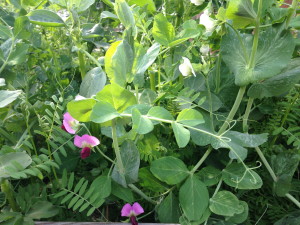When I first started gardening, I was focused on making sure that the plants were well tended. Watering them regularly and feeding them with fertilizer were on my list of regular garden tasks. Over the years, I have become more interested in focusing on the soil. Research has shown that if you have the right soil biology, the plants will thrive. I focused on adding organic matter to the soil in the form of compost and compost tea. I also started growing cover crops (a mix of plants that are grown specifically for feeding the soil) in my vegetable garden beds to improve the soil. Here are a couple of pictures of typical cover crops of bell beans, vetch, and oats growing this winter. I think the blooms are quite lovely.
Once the plants start to bloom, I cut them down just to the soil surface, cutting the stems up in pieces, and add a layer of compost over them. I don’t till them in so that I don’t disrupt the soil life. I wait another month or so until the plants have broken down before I transplant vegetables into the beds. If I’m in a hurry to plant, I may cover the bed with plastic for two to three weeks to help break down the cover crop a little faster. I have noticed that using the compost, compost teas and cover crops has increased the production in my vegetable garden. If you want to read more on the topic of soil biology, I recommend that you read articles written by Dr. Elaine Ingham, a soil microbiologist and author of “The Soil Food Web.” Another good resource for composting is Barbara Pleasant and Deb Martin’s book, “The Complete Compost Gardening Guide”.
I encourage you to feed the soil organisms rather than the plants for a healthier and more productive garden this spring.
Happy edible gardening!

